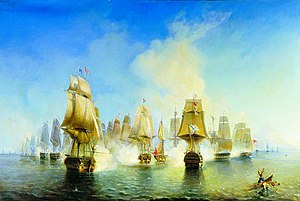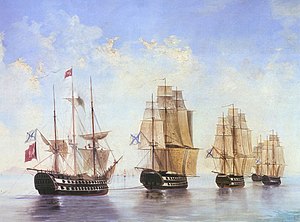Battle of Athos
The naval Battle of Athos (also known as the Battle of Monte Sancto and the Battle of Lemnos) took place from the 19 to 22 June 1807 and was a key naval battle of the Russo-Turkish War (1806–12, part of the Napoleonic Wars). It was fought a month after the Battle of the Dardanelles.
| Battle of Athos | |||||||
|---|---|---|---|---|---|---|---|
| Part of the Russo-Turkish War (1806-1812) | |||||||
 The Battle of Athos by Alexey Bogolyubov | |||||||
| |||||||
| Belligerents | |||||||
|
|
| ||||||
| Commanders and leaders | |||||||
|
|
| ||||||
| Strength | |||||||
| 10 ships of the line | 10 ships of the line, 5 frigates, 3 sloops, 2 brigs | ||||||
| Casualties and losses | |||||||
| 78 killed, 172 wounded[1] |
3 ships of the line, 2 frigates, 1 sloop 774 prisoners[1] | ||||||
The battle was triggered by Dmitry Senyavin's retreat from the Dardanelles, which he had been blockading since March, towards the Russian naval base at Tenedos. The Ottoman commander, Kapudan Pasha Seydi Ali Pasha, ventured with 9 ships of the line, 5 frigates and 5 other vessels out of the strait into the Aegean Sea. Thereupon Senyavin returned to cut off his retreat and fell upon the Ottoman fleet halfway between Mount Athos and Lemnos. Trying to avoid a battle or distraction from Tenedos, the Turkish fleet went around him on the south side and rushed to the west. Senyavin, leaving the smaller ships to help the fortress, set out to find the enemy, and found him on 19 June in an unsettled situation at anchor between the island of Lemnos and Athos Mountain.
From his previous experience, Senyavin had learned that the Ottomans fought bravely unless their flagship was sunk or taken captive. He therefore ordered Aleksey Greig and other captains of his ships of the line to concentrate their attack on the three Ottoman flagships, whilst other Russian vessels were to prevent Ottoman frigates from delivering help.
The Russians approached in two parallel lines of five ships of the line each, turning north to run alongside the Ottoman line. During the battle 3 Ottoman ships of the line and four frigates – around one third of the Sultan's fleet – were either sunk or forced aground. The rest retired to the safety of the Dardanelles. On the way they scuttled another ship of the line and a frigate near Thasos on 4 July and lost a frigate and a sloop near Samothrace on about 5 July.
In the morning of 20 June it was revealed that the whole Turkish fleet, running before the wind, was going north to the island of Thassos. A ship of the line and two frigates (the former captain of the ship helped Bey) were cut off their squadron by the Russians. On 21 June Senyavin dispatched rear-admiral Greig with three ships of the line in pursuit of the latter, but the Turks ran their ships ashore and burned them. At dawn of 22 June in the retreating Turkish squadron exploded another ship of the line and a frigate, and two damaged frigates sank off the island of Samothrace. Of the 20 Turkish ships in the Dardanelles, only 12 returned.

On 23 June Senyavin decided not to pursue the enemy and return to help beleaguered Tenedos. However, due to the wind and calms he arrived there just on 25 June. Turkish troops surrendered, and, leaving all their guns and arms, were transported to the Anatolian coast.
As a result of the battle, the Ottoman Empire lost a combat-capable fleet for more than a decade and signed an armistice with Russia on 12 August.
See also
- Order of battle at the Battle of Athos
- Dardanelles Operation
Citations
- Горский, В.; Воронин, В.; Волков, Владимир (2020). Военная история России с древнейших времен до конца ХIХ в. Учебное пособие. Прометей. p. 198. ISBN 978-5-457-97631-3.
References
- Bond, Brian. & Roy, Ian. War and Society London (1977) ISBN 0-85664-404-8
- Lebedev, A. A. Dardanelles and Athos: behind the scenes of the famous victories // Gangut. 2013. No. 78.
- Naval wars in the Levant 1559–1853 (1952) – R. C. Anderson. ISBN 1-57898-538-2
- Tredrea, John; Sozaev, Eduard (2010). Russian Warships in the Age of Sail, 1696–1860: Design, Construction, Careers and Fates. Barnsley, UK: Seaforth Publishing. ISBN 978-1-84832-058-1.